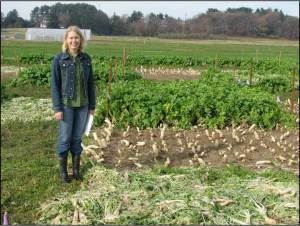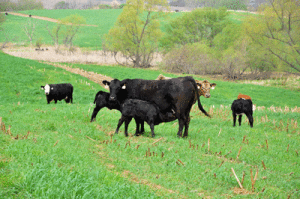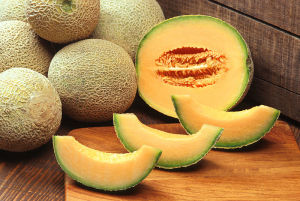If you got your cover crops in early, you might be looking at lush, verdant fields now.* I find that this lushness tends to make farmers either want to feed their animals or feed people, especially when it’s a cover crop like turnips or radishes. Ultimately, the purpose of a cover crop is to feed the soil, but feeding animals and people along the way may be compatible with achieving this goal. It just depends on the situation.
Livestock grazing cover crops
You have to know what you want your cover crop to do for you and whether grazing will take away from the cover crop functionality. I don’t want to make any claims I can’t substantiate, so I defer to others on many of the livestock grazing questions. Here’s a quick summary from Penn State of the factors to consider when deciding whether to let your livestock graze on your cover crops and whether to include cover crops in your rotation for this specific purpose.
Manure management concerns with grazing and vegetable production
For the purposes of growing no-till vegetables (or even vegetables with tillage) the following year, grazing cover crops raises some regulatory concerns about manure application/incorporation.
Currently, the Food Safety Modernization Act defers to the national organic standards with respect to manure, requiring 120 days between manure application and harvest for crops that contact soil and 90 days for crops that do not contact soil. The organic standards raise some questions about no-till because of the word “incorporation.” However, FSMA uses the word “application.”
For the reasons I’ve discussed here, grazing cover crops prior to vegetable production is possible, but requires attention to timing to comply with regulations intended to safeguard food safety. Rest assured that you don’t have to graze cover crops to get tremendous benefits. In fact, cover crops can be a key plant-based way to maintain and improve soil quality and return nutrients to the soil without using manure.
Human grazing of cover crops
We have a lot of very large purple top turnips in a field after we harvested what we could sell. A friend was visiting and said “do you think you could get some gleaners to come in and clear this out?” Maybe, but despite my desire to feed people, I also want to feed the soil. I’d rather leave them there as a cover crop. Likewise, if you have a cover crop like radishes or turnips that you don’t intend to use to feed people, it doesn’t do a lot of damage to take a few for this purpose, perhaps making a buck or two along the way.

Yvonne Lawley found that removing the tops (and roots in farther plot) of radishes in late fall did not influence the weed suppression in spring because the weeds had already been suppressed. Photo: Ray Weil.
Harvesting a small portion of the turnips or radishes from throughout the field this time of year will not dramatically impact the functionality of the cover crop. By now, radish has already suppressed the weeds. Removing ALL the biomass from the field will leave the soil susceptible to erosion and will remove all the nutrients stored in the biomass.
Unless you take a substantial portion of the crop, however, you will still see an increase in nitrogen and sulfur availability in spring. By now, the roots have done the bulk of their biodrilling.
Beyond boiled dinner
Turnips are a familiar (even if not very popular…) crop to many Americans, but forage radish, or daikon, is less familiar. This time of year, when the weather has gotten cold, daikon mellows out and becomes almost sweet when eaten raw. In fact, there is a lot of sugar in daikon and when cooked, the sweetness really comes out. I wrote about eating daikon after my trip to Japan earlier in the year, so I won’t repeat myself here. Suffice it to say, some quick Internet searching for “daikon” will yield myriad recipes.
Here’s to soil health, your livestock health, and your health through cover crops.
*if you got your cover crops in early and your fields are not lush, get in touch! We might be able to help figure out why.





